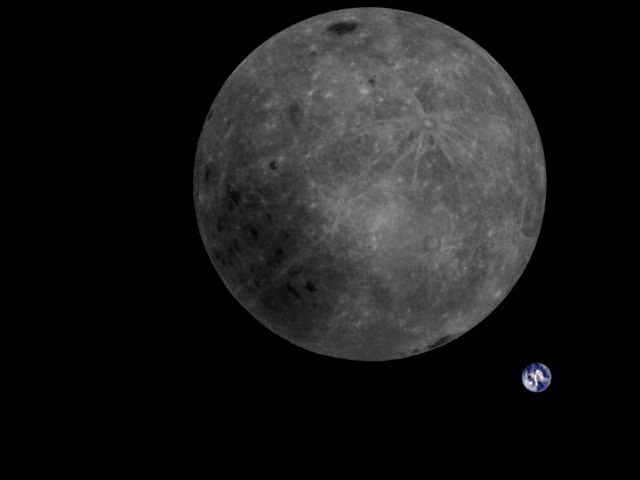Create a free profile to get unlimited access to exclusive videos, sweepstakes, and more!
The Earth peeks out from behind the lunar far side
One of my favorite kinds of photos is one where we see something familiar in an unfamiliar way. Perhaps it's from an unusual angle, or the lighting is odd, or the colors distorted in such a way that it takes you a moment to wrap your brain around what you're seeing.
It's one reason I love optical illusions so much, but it also sometimes applies to astronomical imagery as well. It doesn't happen often, mostly because we don't get a chance to see, say, the other side of a distant nebula or galaxy. They're too far to actually visit.
But some things in space are close enough to visit, and we in fact do go there… and beyond. And when we do, the view we get is remarkable not just for its beauty, but for its vantage.
That lovely photograph was taken on February 3, 2019, by the Chinese Longjiang-2 satellite, which is orbiting the Moon. It's a small photo, just 640x480 pixels, but what it shows belies its size; that is the Earth and Moon in one shot, a single image framing all of humanity.
Doesn't the Moon look strange? That's because you're seeing the far side — in fact, the geometry dictates the only way to see the Earth and Moon together in one shot from lunar orbit is if you are over the far side at the time.
But that's the side forever pointing away from Earth, so we cannot see it from the ground, or even low Earth orbit. To see this terrain you have to go to the Moon and then a bit past it; this view is a gift of the space age.
Unlike the near side, the far side has far fewer dark plains (called maria), possibly because the crust is thicker on that side. There is one visible in this photo; Mare Moscoviense, a lava-filled plain some 280 kilometers across. The crater with the extensive ray system is Jackson, which is about 70 km wide (the rays are plumes of material blown out by the impact). Now, I can identify features in this image all day long, but it won't remove the feeling that you're seeing an alien world.
Because you are.
And I love the Earth there, peeking out in its polychromatic hues. Look how small it is! In fact, measuring the relative size of the Earth and Moon, knowing their actual sizes, and the Moon's distance from Earth at the time, I can estimate how far Longjiang-2 was from the Moon when it took this shot! I get very roughly 8,800 km, which would put the satellite very near the apex of its 200 x 9,000 km orbit around the Moon when this photo was taken*.
Science! And in this case, Math!
There's even a time-lapse of sorts showing the Moon moving past the Earth due to the satellite's motion:
So what is Longjian-2 doing way out there? Well get this. In Early January the Chinese Moon lander and rover Chang'e 4 and Yutu 2 soft-landed on the Moon's far side. Since they were on the other side of the Moon, direct communication wasn't possible. So, in May 2018 the Chinese space agency launched a relay satellite called Queqiao ("Magpie Bridge") into lunar orbit, so that it could listen for the lander and rover and relay their signals back to Earth. Along with it they launched two microsatellites called Longjiang-1 and -2 ("Dragon River 1 and 2"). A malfunction left Longjiang-1 stuck orbiting the Earth, but Longjiang-2 made it to the Moon.
It's an astronomical satellite, observing the sky at low radio frequencies (1 – 30 MHz), using the Moon itself to block our radio-noisy Earth. Also on board, though, are two small cameras, one developed in Saudi Arabia and another by Chinese students. You can read more about this at The Planetary Society.
By the way, the bitrate that far from Earth, and with such a low signal strength, is so low that it took 20 minutes to download this small 16k image from the Moon! It was received at the Dwingeloo radio observatory in the Netherlands (that page has more of the story, and more images, too).
So this was a multinational effort, as befits an otherworldly view of a familiar place.
More images from the camera are online, too, as you can see not all are framed as well. It's not easy aiming such a camera, especially when you have to know all the orbital mechanics to know where it's pointing and what it will see when. This is exactly rocket science.
With more countries jumping into lunar exploration, I wonder how long it will be before we get used to photos like this. My hope is never.
*I leave the math for enthusiastic readers, but beware measuring the sizes of the Earth and Moon interjects pretty big uncertainties into the equation. The Moon was about 410,000 km from Earth at the time, too.



























